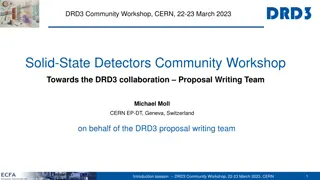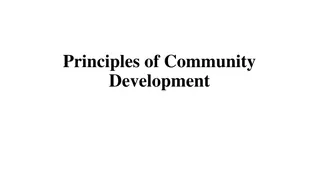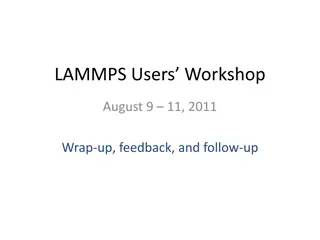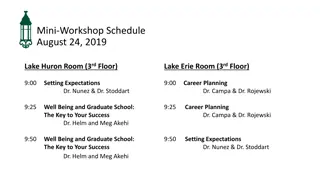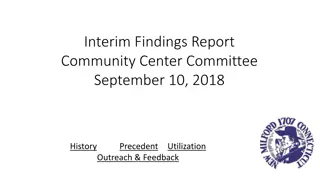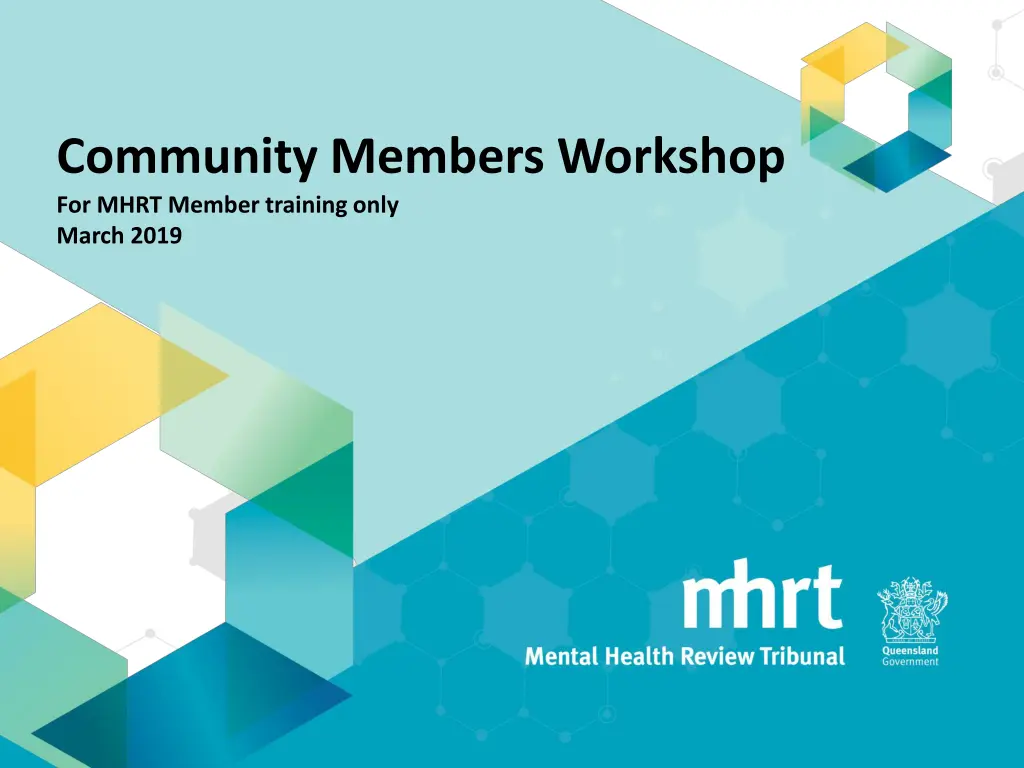
March 2019 Community Members Workshop for MHRT Member Training
"Join the March 2019 Community Members Workshop for MHRT Member Training to discuss legal principles, mental health practices, and more. Engage with fellow community members in a safe and open environment."
Download Presentation

Please find below an Image/Link to download the presentation.
The content on the website is provided AS IS for your information and personal use only. It may not be sold, licensed, or shared on other websites without obtaining consent from the author. If you encounter any issues during the download, it is possible that the publisher has removed the file from their server.
You are allowed to download the files provided on this website for personal or commercial use, subject to the condition that they are used lawfully. All files are the property of their respective owners.
The content on the website is provided AS IS for your information and personal use only. It may not be sold, licensed, or shared on other websites without obtaining consent from the author.
E N D
Presentation Transcript
Community Members Workshop For MHRT Member training only March 2019
Agenda 5:00 5:15 5:15 5:45 5:45 6:15 Welcome and introduction The role of the Community Member Legal principles interpretation and decision making Statements of reasons Good mental health practices update - Top tips about 6:15 6:45 6:45 7:00
Today Housekeeping: We have participants in the room and via Blackboard. If you would like to make a contribution (which we encourage!!!): for those in the room please ensure you are speaking loud and near a microphone for those on Blackboard please type your question/comment For those on Blackboard please ensure your microphone is off.
Today Purpose: We wanted to create an opportunity for community members to get together (even if not physically) to be able to discuss issues/matters that are unique to community members. Use this as an opportunity to ask questions (none are silly), test your understanding and share your experience.
Today How we propose today will work best: Respect everyone s views Open and safe environment Talk, listen and learn Engagement will produce the best outcomes Chatham House Rules.
Questions Any questions before we get started?
Expectations for all Members Communication with the Tribunal Office You need to know: Code of Conduct COAT manual Communiques Website/email content: Fact Sheets Recent MHC cases these are not just for lawyers Professionalism and independence Consider your social media presence
Expectations for all Members Preparation for hearings Travel Requirements Training and Development Requirements Auditing member eligibility, L&D participation, competencies
What does the Act say? For what we call community member , a person is eligible for membership if they have other qualifications and experience the Minister considers relevant to exercising the Tribunal s jurisdiction. The Minister must also be satisfied that the person has the competencies developed by the President.
Question to consider How would you describe the role of the community member?
The role of Community Member An equally contributing member. Not restricted to an opinion on strictly areas of their experience/qualification. Can use their knowledge and experience to contribute to the deliberation in the same way as a legal and medical member. Ways matters decided between members (s752): Tribunal s decision on a question of law is the decision of the presiding member. If no lawyer refer question of law to another legal member to decide. If Tribunal divided in opinion about decision on another question if there is a majority of the same opinion or otherwise the decision of the presiding member.
What is unique about Community Members? Appointed for their expertise and knowledge of matters relevant to the decisions to be made by the Tribunal. What are some examples of the expertise of our community members? Social supports? Rehabilitation? Programs? Goals/plans? Level of engagement? Risk factors? Transition? Be able to ask the right questions to draw out clinical evidence from treating teams. Be able to ask the right questions of the patient to elicit important information. Assess the psychosocial factors impacting a person s mental condition. Be able to bring additional perspectives to the decision making process.
Treatment / Case Management The Tribunal receives evidence from Treating Teams to make its decisions clinical reports, other reports, oral evidence. As we have discussed, Community Members assist the Tribunal to understand, assess and apply this evidence to its decision making. Treating Teams are not parties to the proceeding, they are there as witnesses that is, to provide the Tribunal with relevant information. Treating Teams do not have the right to be heard or be represented at hearings.
Treatment / Case Management The panel may be questioning whether they have sufficient evidence to reach a decision on a particular question. It is not the role of the Community Member to take the place of the Treating Team and provide evidence about areas in which they have expertise. If the Community Member considers that the Treating Team is failing to consider a particular factor, they may suggest to the panel that a second opinion is needed (e.g. a TOE). In which circumstances may this occur? Any examples?
Treatment / Case Management It is important that the panel remembers that their role is to make a decision based on the criteria set out in the Act. The panel must be careful not to stray into: diagnosis treatment case management. How do Community Members draw this line? For some Community Members - What about differences in interaction with patient when you are in your other role as opposed to when you are on a Tribunal panel? Any examples?
Questions Any questions before we continue?
Legal Principles Update Most updates of a legal nature are addressed in the Q&As section of the monthly communique. Any that you have seen of late that you would like to clarify/discuss?
Admin Law Principles Body of law that structures and controls the exercise of public power. For the Tribunal s purposes, we are concerned with: exercise of the jurisdiction we have been given natural justice We will cover this only briefly here as we intend to conduct an Admin Law principles Masterclass later in the year.
Jurisdiction The Tribunal is a creature of statue . The Tribunal can only do things (including make decisions) that the MHA2016 says it can do. This is why it is very important to stick to what is in the Act. What decision can you make? e.g. section 419 says that when conducting a periodic review of a TA the Tribunal must decide to confirm the authority or revoke the authority. What is relevant to your decision? e.g. section 412 says that when making a decision in relation to a review of a TA the Tribunal must have regard to the person s relevant circumstances. How do you make the decision? e.g. section 421 says that the Tribunal must revoke the authority if the Tribunal considers the treatment criteria no longer apply or there is a less restrictive way for the person to receive treatment and care for their mental illness.
Natural Justice Section 733(3) of the MHA2016 requires the Tribunal to observe the rules of natural justice. Natural justice is used to describe a collection of rules, the aim of which is to safeguard the rights of a person the subject of a hearing. Hearing rule Rule against bias No evidence rule Rules are not absolute in content and scope. Flexible nature of the decision-making body, subject matter, rules under which the decision-making body operates, urgency of the situation, circumstances of the matter.
Natural justice Hearing rule The right of a person to be given notice of relevant matters and to be provided with the opportunity to present his or her case. patient is entitled to attend the hearing and may speak at the hearing. patient must be given a copy of documents and information that the MHRT will consider, including the clinical report. patient must receive clinical report at least 7 days before hearing to be given a fair chance to consider it and prepare submissions. entitlement to have a representative exceptions to this rule are specified in the Act (e.g. confidentiality orders) restrictions on disclosure of a victim information statement.
Natural justice Rule against bias Refers to the entitlement of a person to an impartial hearing, free of actual or apparent bias. A suspicion of bias can arise from things the decision-maker says or does that indicate s/he may have formed prejudgments and is not open to persuasion. Tribunal has a conflict of interest policy to guide members in making decisions about whether to hear particular matters which may create an actual or apparent bias. Tribunal rotates members across different matters and locations. Tribunal members are independent and not subject to direction in their decision-making.
Natural justice No evidence rule Requires that a decision be made on logically probative evidence. A decision-maker may only take into account those matters that are relevant and are required to be considered. Tribunal members are required to consider the criteria and factors for each decision specified in the Act. Parties may request a statement of reasons.
Breach of natural justice If a party to the proceeding believes that the MHRT has not complied with the rules of natural justice when making a decision, the party may wish to appeal the decision to the Mental Health Court. Who may appeal to the Mental Health Court is set out in Schedule 2 of the Act.
Why do we need to write SORs? Section 756 requires the Tribunal to, on request, given written reasons for the Tribunal s decision. Tribunal must comply within 21 days after receipt of request Request must come from a person who was entitled to be given notice of the hearing of the proceeding.
What is the purpose of SORs? A good SOR will explain why the decision was reached more than simply a statement of the evidence and the decision. To provide transparency in Tribunal decision-making To enable person requesting it to understand the decision To enable person requesting it to decide whether to appeal and on what grounds To defend your decision-making process Any others?
What does the Tribunal do when it receives a request for a SOR? When the Tribunal receives a request for SOR, it checks the request is valid and then sends the request, the materials before the Tribunal and the decision paperwork to the member noting its due date. Ordinarily this will be the presiding member, however, this may also be asked of other panel members. For example, if presiding member is away, unwell, has other commitments or has multiple SORs to complete. It is expected that members prepare the SOR and circulate it amongst the other panel members for input/clarification/confirmation prior to providing it to the Tribunal.
Where can I get help? Review the Tribunal s Style Guide includes information on what to include, how to treat submissions, format requirements. Follow the template for the particular matter type. Review the de-identified examples on the Tribunal s website (Members-only section). Call the Tribunal Annette, Virginia, Kimberley or Michelle.
Ok, so Im going to write a SOR what do I need to cover? MHA 2016 does not specify content. Acts Interpretation Act 1954: If Act requires a tribunal making decision to give written reasons, instrument must also: set out findings on material questions of fact. refer to the evidence or other material on which those findings were based. In essence: Set out your decision. Describe your findings in relation to the criteria and the evidence you relied on to reach those findings. If you do not set out your findings about a material fact, the inference may be that you did not consider that fact. Give the reasons for your decision.
What are some tips when writing about the evidence? Must refer to the evidence upon which the findings of fact are based. Requires more than simply stating the evidence presented at the hearing. Consider what you took into account from the documents also. Consider how best to synthesise the evidence no need to copy large portions of text from documents. Explain whether the evidence was accepted or rejected and why. What part of the evidence was persuasive? Give thought to the weight given to evidence and why. Where you are faced with conflicting evidence, state your reasons for preferring one over the other.
Can I have an example of how to explain my reasons using the evidence? A treatment authority was revoked because the patient was found to have capacity: The Tribunal found the patient to be well educated and informed regarding her illness and her mental state had been stable for a significant period of time. Furthermore, the patient was agreeable to a prolonged period of taking her medication and was keen to work collaboratively with the treating team on her mental health, even as a voluntary patient. As a result, the Tribunal formed the view that the patient does have the capacity to consent to treatment for the illness.
Another example The Tribunal confirmed a treatment authority this section particularly related to risk of harm: The Tribunal heard evidence from the treating team indicating that the risks at the time of the hearing were consistent with those identified in the clinical report, namely, there is chronically a very high risk of harm through self- harm, evidenced by multiple previous suicide attempts. Mr B is also at risk of harming others through his aggressive outbursts and was noted by CFOS to be considered a high risk of future violence. In addition, Mr B has indicated previously that he has had thoughts of a sexual nature regarding children and following the CFOS assessment, he was identified as being a moderate risk for future sexual violence against others. In terms of chronic behavioural risks, Mr B has demonstrated a pattern of absconding from his accommodation and the hospital ward which the treating team indicates increases his risk of vulnerability in the community due to his intellectual impairment and mental illness. The Tribunal considered the evidence in relation to Mr B s inability to understand and retain information about his ongoing treatment needs as well as evidence of his ongoing pattern of violent outbursts, self-harm and absconding behaviour and considered that without involuntary treatment Mr B is at imminent risk of harm to himself and others.
Can I have an example of how to summarise from the clinical report? Where a clinical report provides a list of incidents of violent/inappropriate behaviour while an inpatient with dates and specific actions, you may wish to summarise this in a paragraph: The clinical report outlines that during his admission C had periods when he had displayed sexually disinhibited behaviour, sexually inappropriate behaviour towards female co-patients and nursing staff, aggressive behaviour, and intimidating behaviours towards co-patients and staff. Oral evidence at the hearing provided by Drs A and B outlined that C has a history of sexually disinhibited behaviour and recent over-familiarity. There is low level disinhibition recently, but overall maintains his boundaries.
What about an example of a good conclusion? The Tribunal approved ECT treatment for a patient: Having considered the RANZCP guidelines on treatment for mood disorders, it is clear there is evidence that ECT is the treatment of choice in psychotic depression where the risks are likely to be high, as they are in Mrs X s situation. Dr A s evidence was that past treatments have produced significant improvement and that Mrs X s best mental state was achieved during the most recent course of ECT. The Tribunal considered the potential negative impacts of ECT, however in the face of major risks of her illness and Mrs X s suffering, it accepted the evidence that the benefits of ECT as an acute and a maintenance treatment, were important to maintaining some stability in Mrs X s mental state. The Tribunal therefore approved the requested course of ECT treatment.
Can I include some positive statements about the patient s progress? It can be useful, in some circumstances, to acknowledge the progress that a patient has made. For example: At the review of her treatment authority, Z read from a written statement which she had prepared herself. This was a very comprehensive statement and the Tribunal was grateful for this contribution. The Tribunal was impressed by X s ability to present her opinion. The Tribunal understands that X finds it difficult to accept her diagnosis and that she has found hospitalisation in the mental health ward a difficult experience.
Can I leave information out of a SOR if there has been a confidentiality order? Section 756(3) requirement to provide SOR does not apply to the extent complying with the request would contravene a confidentiality order or section 743 (restrictions on disclosing VIS). Suggest this is read as SOR is still to be provided, save for the fact that it is prepared to remove any confidential information if going to the patient. If SOR is requested by patient or legal representative and there is confidential information: If legal rep entitled to information draft one version for legal rep and separate version for patient. If legal rep not entitled to information draft one version for patient and legal rep. If requested by person entitled to information can provide version containing all information For such matters, SORs marked with Confidential stamp
Any guidance on considering Victim Impact Statements in a SOR? Where you are referring to a VIS, consider the language used and balance being empathetic to the statement of the victim and the recovery of the patient. For example: The submission confirmed the trauma and impact of the offences upon the victim and the lasting effect on his sense of safety The Tribunal considered that the material confirmed the seriousness of the index offence and the understandable impact upon the victim. The submission was taken into account with other material and viewed in light of the patient s good response to treatment and wish to apologise to the victim.
What are the format requirements? Language Clear, unambiguous, intelligible to the person seeking it. Avoid generalities and vague terms. Do not use technical terms unless likely to be understood or have defined. Avoid acronyms (e.g. TT for treating team) without definitions. Write in plain English say what you mean. Be aware of active and passive voice passive voice can be vague (e.g. A mistake was made. Who made the mistake?) Use headings where appropriate follow the template. Give thought to inclusive language see Style Guide for terminology guidance. Length Depends on the complexity of the matter. Avoid repetition.
Format requirements cont. Annexures There is an annexure for each SOR type that contains the relevant law. Templates There is a template for each matter type. These are available online. Currently under review modified template being trialled by some members.
Any last tips and tricks? Be consistent throughout the document: Names e.g. Mr or James MHRT or Tribunal If you have defined a term, use the capitalised term consistently. Proof-read: spelling, formatting, punctuation. Avoid repetition. Write in short, clear sentences. Avoid long bullet point lists or very length paragraphs. If you are using direct quotes, make sure you attribute those quotes. What other tips/tricks do you have?
Questions Any questions before we continue?
Good mental health practices As Tribunal members, required to engage with material that may be upsetting, concerning or traumatic. In this topic, we would like to facilitate discussion, to the extent members feel comfortable, about what we can do to look after ourselves and each other. Q: How do you recognise in yourself that you have found a particular matter / day challenging?
Good mental health practices Q: What can you do to look after yourself and protect your mental health and wellbeing? Q: What might you do if you noticed that a fellow member may need support?
Good mental health practices What is available from the Tribunal: The Tribunal encourages members to debrief at the conclusion of a hearing day if anyone has concerns. Members can contact their mentors. Members are welcome to contact the President, Deputy President or A/Executive Officer. Members can make use of the Employee Assistance Service (EAS): https://qheps.health.qld.gov.au/hr/staff- health-wellbeing/counselling-support
Vicarious Trauma Training Vicarious trauma negative consequences that a person experiences (can be across time) from engagement with persons suffering trauma or traumatic material. Can be a normal response to engagement with traumatic content. We are currently arranging some vicarious trauma training for both staff and members (separate sessions). Recognise potential impacts on wellbeing and resilience associated with MHRT work Adopting a biopsychosocial approach to understanding the effects Identify early warning signs and awareness of when to seek assistance Develop a self-care plan for enhancing resilience Identify barriers and enablers of routine self-care.
Questions Any questions before we finish?



